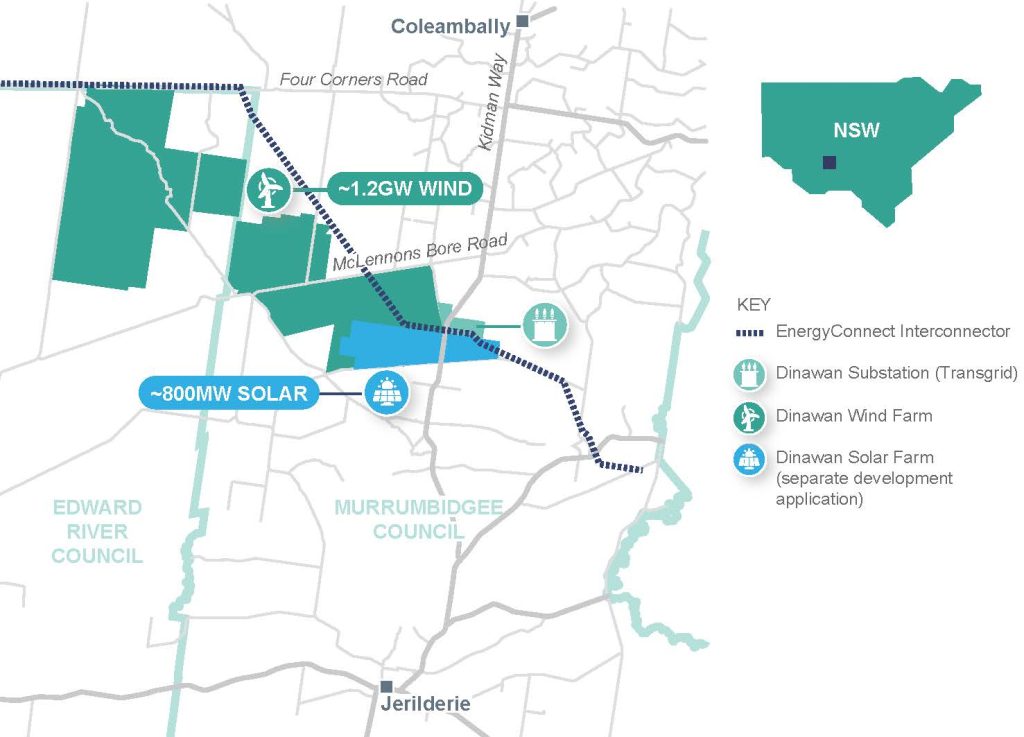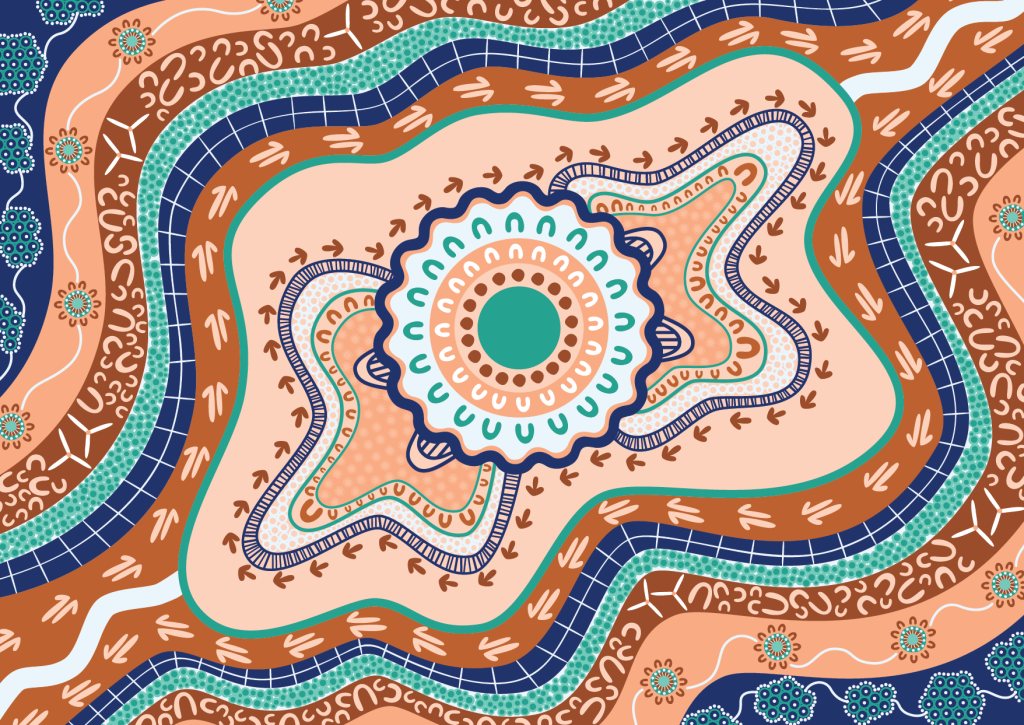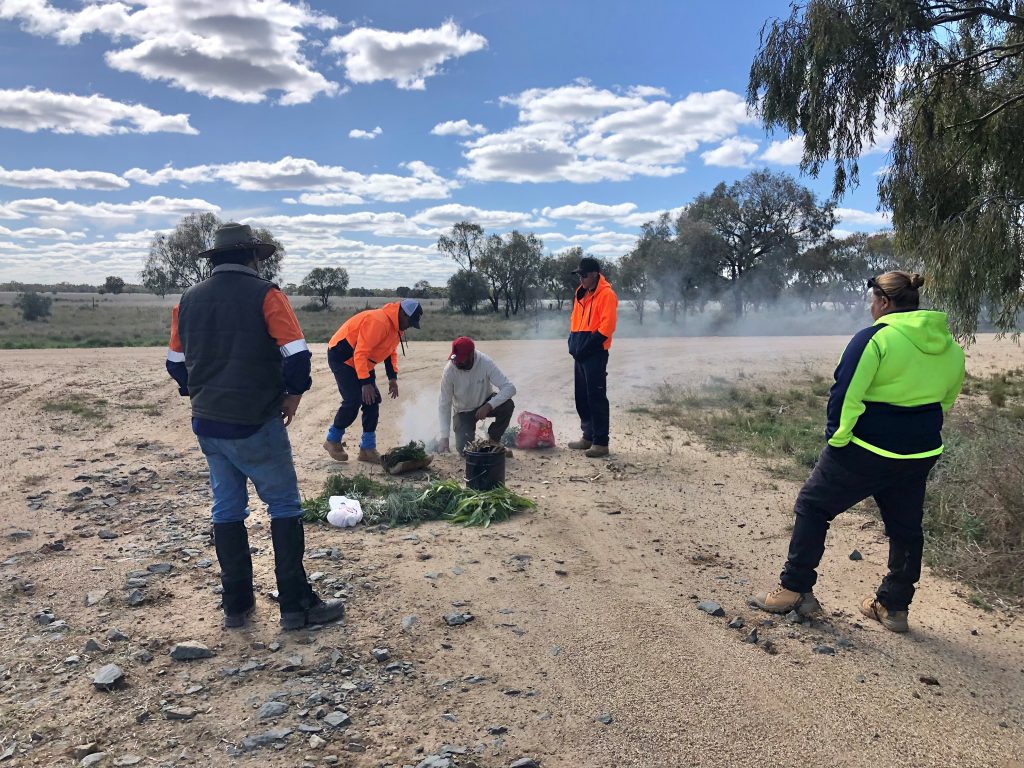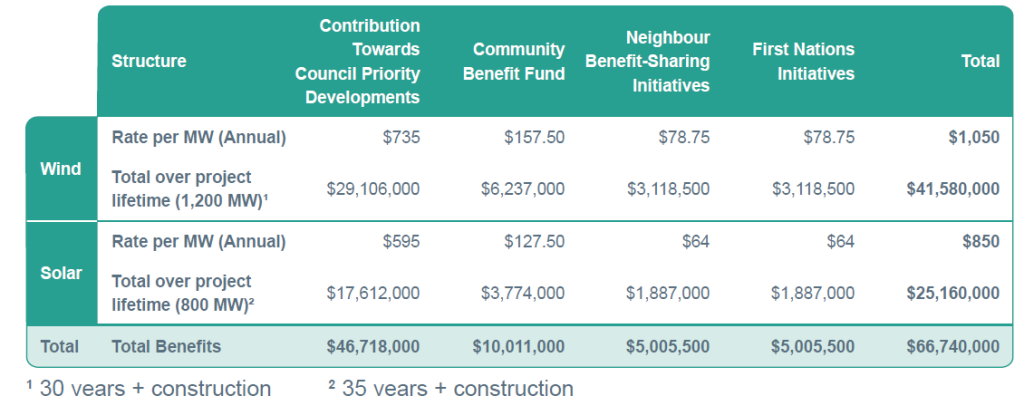Dinawan Energy Hub Community Newsletter #5
This is the news update provided to the community ahead of the public exhibition of the Environmental Impact Statement for the Dinawan Wind Farm from 12 July to 8 August 2024. Find out about the overview of the project, latest news, status of the planning process, and community benefit sharing.
Download the PDF newsletter here: Dinawan Energy Hub – Community Newsletter #5 – July 2024
Introduction
The 2.3 gigawatt (GW) Dinawan Energy Hub (DEH) is a proposed hybrid renewable energy project being developed by Spark Renewables. DEH consists of the Dinawan Wind Farm, and the Dinawan Solar Farm, which would be accompanied by a battery energy storage system.
The DEH is in the South West Renewable Energy Zone, about halfway between Coleambally and Jerilderie near Transgrid’s Dinawan Substation. DEH is proposed on the traditional lands of the Wiradjuri people and several smaller nations of the Murrumbidgee plains.
Spark Renewables is part of the leading Malaysian energy utility, Tenaga Nasional Berhad, a group of companies owning and operating renewable energy projects in Malaysia, Turkey, Ireland, the United Kingdom and Australia.
Overview of DEH
- The proposed Dinawan Energy Hub would consist of:
- Up to 200 wind turbines west of Kidman Way;
- A wind farm with capacity of up to 1.2 gigawatts;
- Wind turbines up to 280 meters high;
- A solar farm with generation capacity of 800 megawatts;
- Ground mounted solar photovoltaic modules installed east and west of Kidman Way;
- Grid connection of both projects via the Dinawan Substation (Transgrid’s Project EnergyConnect); and
- Battery energy storage system capacity of up to 300 megawatts.
Location
- Within the NSW South West Renewable Energy Zone
- Adjacent to new transmission infrastructure
- Close to major transport networks
- Distant from most residences
- Strong wind resource

The story of ‘Nhaway Buraadja’ (Dhurga language for ‘Today and Tomorrow’)
Spark Renewables has had its ‘Reflect’ Reconciliation Action Plan (RAP) endorsed by Reconciliation Australia. We are particularly proud of the artwork created for Spark Renewables by Wodi Wodi and Walbunja artist Lauren Henry and Biripi artist Brittany Cochrane as depicted above.
Can you spot the wind turbines and solar panels? Each element in the artwork layer holds a specific meaning for Spark Renewables.
Through the depiction of people in their yarning circles, wind turbines, solar panels, dinawan (emu) tracks, meeting places and Country, the artwork tells a story of Spark Renewables and its role in up-skilling local community members to provide job opportunities and training to positively impact and give back to community for sharing their knowledge.
The connected yarning circles represent the commitment to continue to grow and remain teachable on cultural safety.
The connected watering holes on the outer layer of the piece represent the flow-on effect of sharing knowledge and commitment to continue on Spark Renewables’ growth journey to better our practices and acknowledge the land we work on as being Aboriginal land.
The RAP can be viewed here.


DEH Pilot Grant Program
Spark Renewables is pleased to announce a Pilot Grant Program designed to provide positive social and environmental outcomes at the local level. Spark Renewables will distribute $20,000 this year to eligible applicants. The Pilot Grant Program seeks to benefit the communities closest to the project, focusing on initiatives within 55km of the proposed project area, which includes Coleambally, Jerilderie and Darlington Point.
The funding priorities for the Pilot Grant Program include:
- Local infrastructure and services;
- Employment or education opportunities;
- Community social benefits, inclusion, health and well-being;
- Sustainability or enhancing the natural environment;
- Heritage preservation, restoration and promotion;
- Outdoor recreational activities, sports and clubs;
- Art and culture;
- Community events and festivals; and
- Youth development.
Spark Renewables intends to transition the Pilot Grant Program into an annual community benefits program for the life of the DEH once the project commences construction. The future amount of the community benefits program will be based on the final size of the project. View more information here.
DEH development pathway
Under planning legislation, the Dinawan Wind Farm and the Dinawan Solar Farm are both State Significant Developments, and therefore require an assessment by the NSW Government. Spark Renewables submitted a Development Application (DA) and Environmental Impact Statement (EIS) to the NSW Department of Planning, Housing and Infrastructure (DPHI).
The EIS for the Dinawan Wind Farm is on public exhibition from 12 July to 8 August 2024. The Spark Renewables Team will be hosting public consultation events. We will be on hand to show study results, share project information and answer any questions. The next phase is ‘Response to Submissions’ where Spark Renewables responds to the feedback received during the exhibition period. Visit the NSW Planning Portal here to view the project documents.
Benefits of the project
- Direct and indirect economic opportunities for Coleambally, Jerilderie and the surrounding region.
- Reduction in greenhouse gas emissions equivalent to up to 3.2 million tonnes per year.
- Up to 600 jobs during construction and up to 50 ongoing jobs.
- Clean, renewable electricity, equivalent to powering more than 700,000 homes.
- Annual contributions to an industry-leading Community Benefit Fund.
Impact avoidance
Spark Renewables has maximised avoidance of potential impacts by:
- Avoiding higher quality native vegetation and threatened species habitat as much as possible.
- Protecting significant heritage
- values identified in consultation
- with First Nations stakeholders.
- Introducing setbacks of at least 2 km between neighbouring residences and the closest turbines.
- Including an on-site accommodation facility to house
- the majority of the project’s construction workforce.
Planning and assessment process

Community benefit fund
Spark Renewables has been consulting with Murrumbidgee Council, Edward River Council and the local community to provide maximum value to the nearby community and local townships. The fund would:
- Contribute towards Murrumbidgee
- and Edward River Councils’ approved priority developments, including new childcare infrastructure and critical
- worker accommodation.
- Fund initiatives to share project benefits with the neighbouring community.
- Provide annual grants to community projects through a fund administered by a committee of Council with local representatives.
- Fund initiatives to share project benefits with local First Nations communities.
The funding would be provided on an annual basis, commencing at the start of construction and linked to the size of the project. The ultimate size of the project will depend on a number of factors including outcomes of the planning assessment process and subsequent conditions of consent, grid connection approval, access rights and detailed design. The table below outlines funding commitments for solar and wind projects.

- Project is located in the NSW South West Renewable Energy Zone (REZ) administered by the state-run Energy Corporation (EnergyCo).
- Funding is additional to the project-led community-benefit sharing above.
- EnergyCo will charge “Access Fees” from projects within the REZ.
- Funding would be administered by EnergyCo for initiatives within the region.
Community purposes (e.g., public or community services or infrastructure, health services or infrastructure): $1,700/MW per year
Employment purposes (e.g., employment programs and associated services and facilities, skills and training programs and associated services and facilities): $600/MW per year
Subsidised electricity and solar and battery systems
Spark Renewables will fund electricity subsidies to all qualifying neighbours within 10km of the Dinawan Wind Farm. The program is intended to serve as an energy rebate scheme, and payments will start when project construction commences and continue through the life of the project. The subsidy amount will be linked to the distance of neighbours’ legal dwellings to the wind turbines.
Spark Renewables will also provide $5,000 towards solar and BESS systems and energy audits for neighbours within 10km of wind turbines, as well as a $5,000 rebate for audits to baseline on-farm emissions. Key features of the Neighbour Benefits Initiative include:
Available to neighbours
within 10km of turbines at
time of construction
Voluntary initiative where
neighbours can choose to opt-in
Public initiative that
is not confidential
